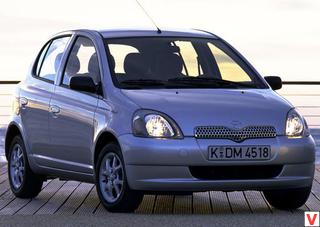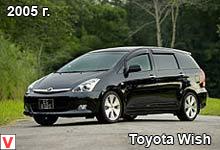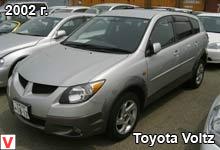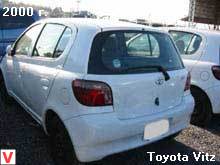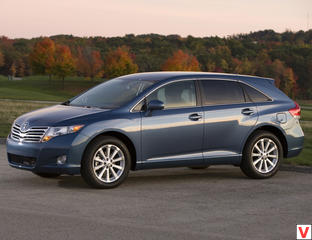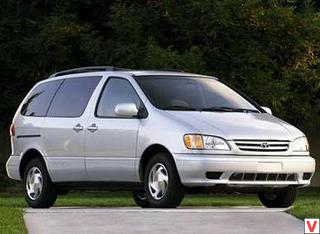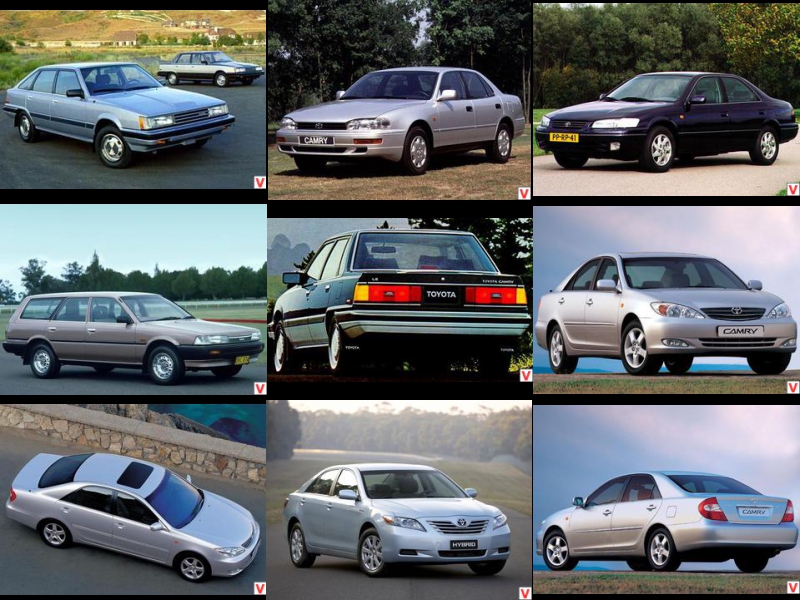
More than twenty years ago, Toyota was one of the first Japanese automakers to take the risky step of creating an interclass car model. Now, for financial reasons, even giants like Volkswagen or Chrysler are unlikely to do this. And twenty years ago, few could afford this. Toyota could.
So, in 1982, the Camry model appeared in the company's production program. The first generation (1982-1986). The first generation Camry was born in 1982. However, for the first time Camry is mentioned back in 1980. The Celica 4 door Camry was the name of a rather bulky (4445 mm long) four-door sedan based on the platform of the famous toyotovsky coupe. The engines on the Celica Camry were installed very mediocre 1.6 and 1.8 liters, both with a lower camshaft. The 1.8-liter engine with a compression ratio of 8.6 developed a power of just 95 hp.
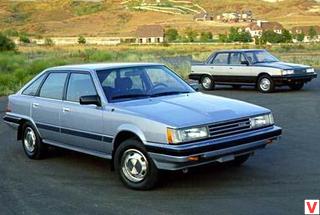
Therefore, neither the advanced design at the time, nor a good option, far from the most expensive version was already the power steering, electric drives of the glasses and electric mirrors did not contribute to the successful sales of this car. So she went into oblivion, leaving his name to the heiress. So, in 1982, the first Toyota Camry appears. From its progenitor Celica 4 door Camry, the new car inherited the overall structure and style of the body. A large for those times three-volume compartment with flat panels and chopped edges was at the peak of popularity.
Of course, as far as possible, it was finalized and the shape of the false radiator grille, bumpers, front optics, and lanterns was changed. There were also corrected body panels and rear wheel arches, which made less. But, interestingly, the Camry, in comparison with the progenitor, added 45 mm in width and length and 5 mm in height. The dimensions of the new car were 4490 x 1690 x 1395. And the main base was increased by 10 mm (previously, its length was 2500 mm). That is, the designers of Toyota, as they could, made more interior space of the car.
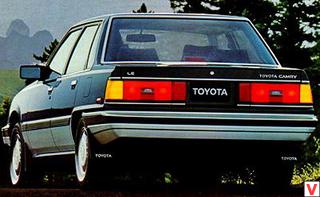
An interesting detail: the rear-view mirrors were originally located in the Japanese fashion of those times on the wings, but subsequently they were moved to their usual place. However, it should be noted that much more is seen in horned mirrors than in ordinary mirrors and they have disappeared solely because of the changed fashion. On the technical stuffing Camry from Celica has gone far ahead. The 1.8-liter engine of the 1S series, the progenitor of a large series of engines manufactured until now, has become the base for the car. At various times, the power of this engine ranged from 90 to 115 hp. (on 1S-ELU series).
At that time, there was a massive transition from carburetor engines to injection engines, so the injection systems on the 1S were installed different carburetor (1S and modifications), central injection (1S-I and modifications) and normal injection injection (1S-E and modifications). This engine had at least one, but the upper camshaft. A year later, the situation with the power supply changed a little under the Camry hood. A two-liter two-shaft engine with a power of 120 hp appeared.
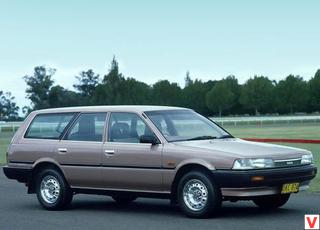
And a little later, the economy lovers were offered a two-liter 88 hp turbodiesel. A five-speed manual was chosen as the base gearbox, but the four-band automatic, which was installed only with petrol engines, was even more common. However, a taste of all the charms of an automatic transmission could be inflicted by Japanese and American drivers. By the way, the versions that went to the United States sometimes differed from the domestic modifications of the cabin. In the standard power steering, electric windows and mirrors, and among the options unique for those times traction control. Some cars were equipped with air suspension.
The fact that even then the Japanese for the picky Americans changed the appearance of the car, making, for example, the bumper slightly more massive, also speaks about market priorities. And also in the USA the five-door hatchback was delivered (in essence being, more likely, the liftback), which was considered a rarity even at home. Europe for Toyota was a secondary market and the cars were sent there on the leftover principle of manual drives instead of electronics, manual transmission instead of automatic, engines of 90 and 107 hp. With the advent of the second generation Camry, the situation has not changed. The second generation (1986-1990 gg.).

The second generation appeared in 1986 and was produced until 1990 in Japan and until mid-1991 in the rest of the world. The dimensions of the car almost did not change 4520 x 1690 x 1395. The Camry was only slightly longer. The remaining dimensions, including the size of the wheelbase, remained unchanged. Toyota designers and marketers correctly calculated that the amount of internal space for a comfortable pastime is enough. And it is true. Camry of the late eighties, for the convenience of the location of the driver and passengers, can compete with the Corolla / Corona of the early nineties, and even with its later versions. Stylistically, the car has changed very significantly.
Although the flat surfaces, fashionable in the eighties, remained, but the corners were rounded, which gave the car a more modern look. But with the technical equipment in the first year of production it was not so good. Initially, the machines were put old units. These engines, although they were modernized, didn’t meet the demands of consumers, because the weight of the car increased by almost two hundred kilograms. So a year later, under the hoods of the Camry, a new generation of engines, more powerful and technically advanced, appeared. The power range of the new units was already from 105 to 140 hp. 4S-Fi new 1.8-liter engine with central injection and 16 valves.
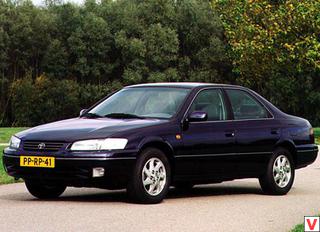
The legendary two-liter sixteen-valve 3S-FE with 136 hp has come to replace the single-shaft engines. A 2-liter turbo diesel 2C-T appeared and a 2.5-liter V-6 2.5-liter VZ mounted on the luxury Camry Prominent, which was produced in sedan and hardtop. Priorities for sales markets have not changed. New cars in all their versions received a richer set. In vehicles supplied to the North American market, ABS appears in the brake drive. As an option for the export Camry even installed collectors, supplying air to the feet of the passengers, located in the backseat! This is not found even in the most modern cars.
The third generation (1990-2001). International. Compared with the previous generation, the new Camry has significantly added in size (4720 x 1770 x 1420) and has radically changed the design. From the old flat forms there was not a trace left for the early nineties, this car looked very modern. Of the features of the body can be noted a huge trunk with a cut to the rear bumper. About the new wagon and say nothing. An indicator of the size of this wagon, is the back door, equipped with two brushes!
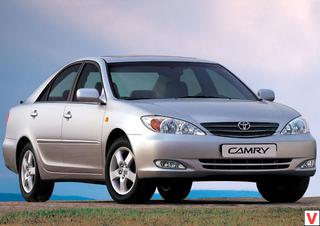
And another interesting detail: from the floor of the trunk you can remove another chair, turned against the course of movement. In this case, the passenger who took this place will not experience any inconvenience. The third generation Camry was produced with sedan, coupe and station wagon. Moreover, sedans for the Country of the Rising Sun and Europe were produced in Japan, and sedans for the USA in Japan and the USA at the new plant in Kentucky TMMK (Toyota Motor Manufacturing Kentucky). Universals and coupes for the whole world (including Japan) were assembled only in the USA.
The third-generation models for the domestic market had two gasoline engines of 1.8 and 2.0 liters, which were mainly aggregated by automatic machines, plus another charged two-liter engine, installed on the GT version and turbo diesel, 2.2 liters in volume. Also, the third generation was supplied with new 5S-FE sixteen-valve four engines, 2.2 liters in volume and two three-liter V6 engines: 3VZ-FE and, later, 1MZ-FE. Budget 5S-FE is very economical gas mileage in urban mode is 9-10 liters, on the highway only 6-7, easy to maintain and quite fast acceleration to 100 km / h with a manual transmission in 9.7 seconds.
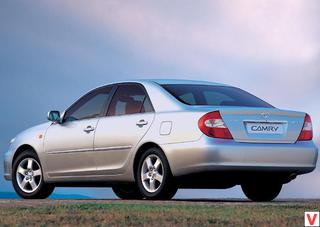
With a V6 engine and mechanics (as well as an automatic transmission too), the Toyota Camry looks like a small jet (acceleration to a hundred in 8.8 seconds). In addition, it is a very quiet engine, practically not giving vibrations. However, the fuel consumption on this engine is 12-15 liters. Front and rear suspension independent. Disc brakes, with front ventilated. In 1998, pre-installed safety belts, side airbags, and immobilizer were installed on cars. It becomes thicker car windshield.
Since 1999, the Toyota Camry is offered to customers in five versions: CE, LE, XLE, LE V6 and XLE V6. Cars are equipped with two front airbags and side, at the request of the buyer, child safety and ABS locks. The basic CE equipment includes a five-speed manual gearbox, folding rear seats, a windshield defroster, height-adjustable steering wheel and an AM / FM stereo recorder. LE is complemented by air conditioning, cruise control, electric windows and a central lock.
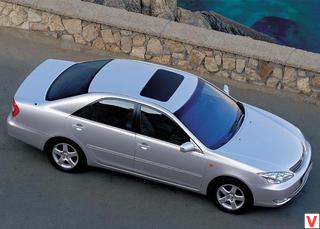
In addition to the above, the XLE kit includes remote door opening, an anti-slip system, automated front seats, a CD player, heated mirrors, adjustable pause wipers and alloy wheels. The fourth generation (1994-1998). Only for Japan.
While the first lineup of the Camry was sold in the United States, in Japan, Toyota had already introduced another generation of its hits. The cars, which grew in size (4625 x 1695 x 1390) and much more solid in design, remained true to the traditions: the Camry is a kind of budget version of a business sedan. All equipment on the machines remained the same as the previous generation.
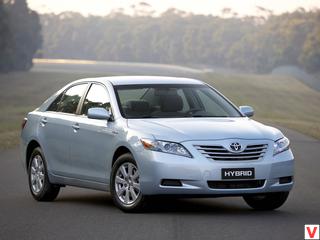
True, no source of information contains information about the GT version. It seems that such ceased to exist. Thus, the developers put an end to the dynamic past of cars and focused primarily on the image quality of models. The new cars turned out to be quite solid, but they again occupied an intermediate niche on the market: it was no longer class D, but not yet class E. The new Camry already had someone to compete with: Mitsubishi had Galant, Nissan Bluebird, Honda Accord with its numerous family.
However, Toyota didn’t give rest to marketers in the full-fledged business segment, in which front-wheel drive reigned for a long time, and the Mark / Chaser / Cresta clearly didn’t fit in with the demands made by buyers. Therefore, it was decided to move to the market a new, larger model, which has a well-promoted name. Fifth generation (2001). The fifth generation Toyota Camry appeared in Japan in 2000. And the world premiere of the new car took place on September 11, 2001 at the Frankfurt Motor Show. The new Camry has received a completely new design, the concept of which incorporates all the latest trends, harmoniously combined with the traditional elegance of business-class cars.

Narrow expressive headlights, chrome-plated radiator, molded bumper, smooth lines that emphasize the ideal shape of the car all this creates a unique look of the new Toyota Camry. Appearance gives a feeling of strength, inspires respect and admiration for the perfection of forms. The appearance of the car speaks of its excellent aerodynamics, which means it reduces wind noise, improves acceleration and speed, while reducing fuel consumption. The drag coefficient is just 0.28.
The new sixteen-valve engine with a displacement of 2.4 liters with the VVT-i system very sensitive to the desires of the driver and driving style. It develops exactly the power that is needed at the moment, with minimal fuel consumption. The increased wheelbase and a wide gauge give a tremendous sense of stability and a guarantee that the car will maintain the trajectory and perfectly “hold the road”.
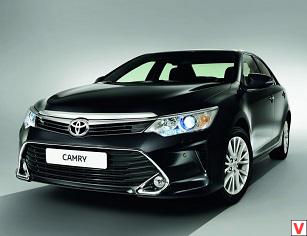
The new VVT-i technology (variable valve timing system) is the basis of the powerful 2.4-liter Camry gasoline engine. The VVT-i adjusts to the driver’s driving style and engine requirements, optimizing the timing and opening time of the intake valves. This allows you to maintain the maximum efficiency, which gives exactly the power that is needed at the moment, with minimal fuel consumption and exhaust emissions. V-shaped twenty-four valve 6-cylinder engine with a displacement of 3.0 liters is the maximum power with minimum effort.
With a torque of 273 Nm at 4300 rpm and a power output of 137 to W / 186 hp at 5300 rpm, it provides 100 km / h acceleration in just 9.1 seconds and a top speed of 225 km / h. In addition, the new Camry is equipped with a four-speed Super ECT automatic transmission with electronic control, which increases the speed and smoothness of gear changes and simultaneously reduces fuel consumption. Salon in the new Toyota has become more spacious. Thus, the car began to respond to higher rates of quality materials used in interior trim. The Camry 2.4 l VVT-i saloon uses high-quality fabric trim and leather trim as an option. And for cars with a 3.0 liter V6 engine, leather trim is standard.

The feeling of exclusiveness of the cabin is created through the use of leather trim lever, chrome-plated inner door handles, as well as wood trim on the console and control panels. Inside the car is really comfortable and cozy. The interior is carefully thought out. This comfortable seats and automatic air conditioning, power windows, excellent sound insulation. By the way, climate control is standard on all models. One of the innovations of the new Camry is to provide the driver with a circular view.
The windshield and side mirrors are covered with water-repellent material, the driver’s side mirror with a wide viewing angle has a heating system, and the inside mirror is equipped with an automatic dimming system. A multifunction display is installed above the center console. He monitors the working parameters of the car, collecting information from on-board electronic equipment. The display shows all the data necessary for the driver: time, air temperature, trip computer readings, including average and instantaneous fuel consumption, average speed and possible mileage on the remaining fuel.

The driver’s side mirror with a wide viewing angle has a heating system, the inside mirror is equipped with an automatic dimming system. A multifunction display is installed above the center console. He monitors the working parameters of the car, collecting information from on-board electronic equipment. The display shows all the data necessary for the driver: time, air temperature, trip computer readings, including average and instantaneous fuel consumption, average speed and possible mileage on the remaining fuel. The driver’s side mirror with a wide viewing angle has a heating system, the inside mirror is equipped with an automatic dimming system.
A multifunction display is installed above the center console. He monitors the working parameters of the car, collecting information from on-board electronic equipment. The display shows all the data necessary for the driver: time, air temperature, trip computer readings, including average and instantaneous fuel consumption, average speed and possible mileage on the remaining fuel. The updated chassis is the basis for the excellent stability and handling of the new Camry. Increased wheelbase and a wide track allow you to place the wheels closer to the outer corners of the car.
This gives a feeling of stability and guarantees that the car will keep the road well and maintain control. Front and rear suspension with MacPherson struts provide a clear and immediate response when cornering. Power steering through the steering wheel conveys a sense of confidence to the driver. High steering sensitivity ensures precise steering. Disc 16-inch ventilated front brakes and 15-inch rear brakes provide effective braking.
Anti-lock braking system (ABS) with electronic force distribution over the wheels (EBD) helps the Camry to maintain manageability during heavy braking or when braking on slippery surfaces by preventing the wheels from losing traction to the road. EBD complements ABS ,, optimizing brake force distribution across the wheels. Working together, these systems prevent the wheels from locking and allow you to go around obstacles during braking. The emergency braking booster BA automatically increases the effectiveness of emergency braking if you quickly brake, but not hard enough on the pedal.
This function is realized by measuring the travel speed and force on the brake pedals and, if necessary, the subsequent increase in brake pressure. Such assistance is barely noticeable, but indispensable, and the degree of its intensity depends on the driver’s action during braking. Stability control (VSC) regulates braking force and engine power, preventing slippage when turning on a slippery road or when turning the steering wheel sharply.
Selective use of brakes on individual wheels prevents understeer or oversteer and helps the driver maintain control of the car. The Traction Control System (TRC) responds to wheel slip when accelerating or turning, automatically reducing engine power and using braking force to eliminate slip and maintain traction. On the new Camry installed wipers with automatic inclusion. In the automatic windshield cleaning system, there is a rain sensor, which, if water gets on the glass, actually results in the wipers. Also provided for the regulation of the intensity of the wipers, depending on weather conditions.
Camry has a strong internal structure. The design, well thought out from the point of view of safety and advanced technologies, will provide a sense of reliability and comprehensive care for the driver and passengers. Like all cars Toyota, Camry has a high strength in collisions.
Front and rear deformation zones, reinforced pillars and bars that protect against side impacts, reduce the deformation of the cab during a collision, as well as reduce the risk of injury to people in the car. To protect the driver, a retractable pedal assembly is additionally provided, which minimizes the likelihood of foot injuries, and a collapsible energy-absorbing steering column, which works in conjunction with seat belts and airbags, reducing the risk of chest injury. All car seats are equipped with three-point seat belts of the inertia type, and behind the clamps are provided that meet international standards for children's ISO seat belts.
The front seat belts have pre-tensioners with force limiters that work together with front and side airbags, ensuring complete safety of the driver and passenger in the front seat. The car can be equipped with side curtain airbags, which increase head protection during side impact. In 2003, the Toyota Camry became the best-selling car in the United States for the sixth year in a row. In 2006, the sixth generation of the Toyota Camry officially debuted at the Detroit auto show.
The length of the car remained the same, but the new Camry is 20 mm lower (1,470 mm) and 25 mm wider (1,820 mm) of its predecessor. The cabin space was increased by stretching the wheelbase to 2,775 mm (plus 55 mm). It was possible to reduce the area of the glazing by raising the lower edge of the glass of the doors.
Strangely enough, the changes from the salon did not affect these changes at all, but the Camry profile became heavier, faster and lost transparency. The interior of the car soundly and functionally. Camry has all the most trivial for this class of car - only in good materials and famous quality from Toyota. The central panel, decorated with blue glass, takes on all possible functions and performs them with dignity and diligence. Devices sparkle even brighter, increased in volume, equipped with larger characters, and arrows for the convenience of the driver have become even longer.
All Camry are equipped with a standard display with readings of outdoor temperature, power reserve before refueling, average speed, average fuel consumption, distance from the beginning of the trip. The steering wheel, adjustable for inclination and departure, is trimmed with both Karelian birch, leather and metal at the same time. On the steering wheel on the left is music control, and on the right is temperature control.
To combat microbes, dust and odors, a plasma ionizer is provided that generates positive and negative ions. The luggage compartment volume of 534 liters in the expensive versions was reduced to 504, which allowed the backrest to be adjusted by 8 degrees. But the seats with unregulated back folded in the proportion of 60:40. The 2.4-liter gasoline 4-cylinder engine was modified by changing the cylinder head and exhaust system.
Capacity of the power unit increased from 158 to 167 liters. with., decreased levels of vibration, noise, decreased fuel consumption (6.9 l / 100 km on the highway and 9.8 l / 100 km in the city). New V6 engine with a volume of 3.5 liters capacity of 277 hp accelerates the car to a hundred in 7 seconds. In the maximum configuration, a six-speed box is added to this engine. Toyota engineers managed to save 21% of parts in it compared to the previous five-step.
The car’s response to a sharp gas pressure has been halved to 0.5 seconds. On all new Camry ABC, EBD, electronic system of distribution of brake effort and the amplifier of emergency braking are installed. Expensive versions are complemented by a system of exchange rate stability, anti-skid system. Finally, if you try to make a turn at too high a speed, without removing your feet from the accelerator, the electronic system will strangle the engine itself and brake the necessary wheels.
The novelty also boasts a two-zone climate control, controlled from the steering wheel, and the 440-watt JBL audio system can exchange information via Bluetooth. On the new Camry, the brake discs are increased by an inch following the transition to a larger radius of the disks from R15 to R16. In addition, new brake pads with a friction coefficient increased by 10% are used. The electronic emergency braking system evaluates the speed at which the pedal is depressed and develops the maximum braking force itself. Safety systems include belts with pretensioners and overload protectors. Two-stage front airbags, side and curtain provide protection for the entire length of the cabin.
Camry is equipped with a collapsible steering column. Head protection is provided by energy-absorbing materials. Seats provide protection from spine and head lash injuries. In 2011, Toyota introduced a restyled model Camry to motorists.
The new model is notable for its interesting forms, modern design, solidity and comfort, as well as the introduction of new technologies. The dimensions of the car are quite impressive: the length of the car is 4825 mm, width is 1825 mm, height is 1480 mm, and the wheelbase is 2775 mm. The main differences from the 2008 model are the updated headlights: front and rear lights and fog. In addition to changing the design, the taillights have become LED, which is fully consistent with world trends. The design of the front part has become more respectable and expressive due to the modified grille.
The side mirrors are in harmony in color with the car body, equipped with repeaters of turning lights for greater safety, treated with a special hydrophilic coating, which does not allow water to linger on the glass. They also got heated and folded for more convenience. Inside, even more comfort and spaciousness. Camry has one of the best in class soundproofing and a unique set of multimedia equipment. In the open spaces of Russia, the model is offered in the Comfort version (in two versions of the gearbox - MCP and AKP), Elegance, Elegance + and Prestige.
The interior in all trim levels is stylishly decorated with wood inserts and equipped with an electrochromic rear-view mirror, which was created specifically to help the driver so that the cars driving behind them would not be blinded by the headlights. All configurations have on board a multi-zone climate control and an air filter with an ionizer. All base trim levels also have rain and light sensors. The new on-board computer will delight with its multifunctionality. Steering wheel with power steering, on it are located audio control buttons, Bluetooth and air conditioning.
For the convenience of forgetful drivers, the car is equipped with a buzzer, reminiscent of forgotten keys in the ignition and warning system of headlights are not turned off. The richest package will please the steering wheel and gear lever with wood inserts, smart system Smart Entry & Push Start. The car is presented with a new 2.5-liter gasoline four-cylinder engine with 181 hp. and an improved 3.5-liter gasoline six-cylinder V-type engine with a capacity of 277 hp Motors are paired with a 6-speed automatic transmission.
For the safety of the driver and passengers, all configurations have ABS with an electronic EBD system and a BA (emergency brake assist). But the stability control system VCS and TRC - anti-skid system, equipped only with cars starting from Elegance +. But an additional brake light, disc brakes on all wheels and front seats, equipped with a special system that prevents injury to the neck, are equipped with all modifications. In standard trim levels, the Camry is equipped with airbags for those sitting in the front seats, and in higher-priced versions, there are also side airbags and driver’s airbags.
From 2011 to 2014, the Japanese made a number of minor improvements and updates: a basic version with a two-liter engine appeared, configurations were revised, several options were added, and at the same time a 277-horsepower petrol V6 was deformed before the “tax” 249 horsepower. On August 26, 2014, the premiere of the European version and the updated Toyota Camry sedan of the 2015 model year was held as part of the MIAS . It is noteworthy that the restyled version of the Camry 2015 for North America was shown back in April 2014. Novelty flaunts a more aggressive appearance, has received a new base engine and a significantly improved interior.
Key changes in the exterior of the sedan occurred in its front end - the car received a narrowed grille, neatly combined with fresh optics, which acquired LED sections, a completely new front bumper with a wide air intake and small round foglights. All this has made the look of the Camry 2015 more sporty. The body profile has not changed much - a long hood and solid feed, a smooth roofline with a powerful rear leg, large and convenient for landing on the first and second row of the door with a barely perceptible, sill line going back to the rear, large wheel arch arches.
Of the new parts, there are elegant rear-view mirrors with LED turn signal indicators, an original and stylish design of R17 alloy wheels. The feed of the updated Toyota Camry sedan has acquired a new bumper with smooth lines and transitions, the ceiling lighting lamps have slightly changed the shape and have found the LED stuffing. The changes not only gave the exterior more aggression, but also improved the aerodynamics of the car, while the dimensions have not changed: the length of the sedan - 4850 mm (+25 mm), width - 1825 mm, height - 1480 mm, wheelbase - 2775 mm, road clearance (clearance) - 160 mm. No less globally, the developers have worked on the interior of the updated sedan.
The interior has changed for the better. Instead of a brutal four-spoke steering wheel, a neat three-spoke steering wheel was made of a darker plastic, the shade of the wood inserts was changed. The instrument panel has also become more modern, in which there are 2 dials of the tachometer and speedometer with the scales of the coolant temperature and fuel level indicator entered in them. And between them appeared 4.2-inch display on-board computer. The climate control unit has also been updated - the buttons have become larger, the display backlight has changed. The round handles for temperature selection are a thing of the past.
The center console has gained a more rigorous appearance due to the presence of a new multimedia system with a touch screen. The basic versions of the Camry are content with the Toyota Touch 2 system without navigation (6.1 inches diagonal). Top picking got a seven-inch display. The manufacturer has significantly expanded the list of optional equipment, in particular, a windshield with functions of heating the zone of rest of the wiper blades or the entire surface is now available.
In the top-end equipment, the sedan received a memory of the position of seats, mirrors and steering column, heated rear seats, tracking systems for “blind” zones and automatic switching of light from the far to the near, as well as wireless charging for the mobile phone. Already in the database the car has an impressive list of electronic assistants, including the ABS, EBD, BAS, ASR and ESP systems. In the more expensive models, the sedan is additionally equipped with a system for monitoring blind spots and an assistant when reversing parking. Worked on improving the soundproofing of the cabin. The Japanese added insulation to the front doors and updated the floor covering.
The 2015 Toyota Camry Sedan received a new base engine featuring more economical fuel consumption. The 148-horsepower unit was replaced by a 4-cylinder in-line aspirated with a 2.0-liter working volume, combined fuel injection and a new variable valve timing control mechanism, thanks to which the engine can operate both in the Otto cycle (main mode) and in the economical Atkinson cycle with later closing of the intake valves (at low loads). The maximum power of the base unit is 150 hp, and the peak of its torque is reached at 4600 rpm and is equal to 199 Nm. The younger engine is aggregated with a 6-band "automatic".
From place to hundred, this modification accelerates in 10.4 seconds, the maximum speed reaches 210 km / h, and the average fuel consumption on the combined cycle has decreased from 8.3 to 7.2 l / 100 km. The other two engines are a 2.5-liter “four” with 181 hp. and the 249-horsepower 3.5-liter V6 remained unchanged. All three engines fully fit the Euro-4 environmental standard and run on AI-95 gasoline. 2015 Toyota Camry.
based on a front-wheel-drive platform with a front independent suspension based on McPherson struts and a rear independent multi-link suspension. During the restyling, the suspension was significantly reconfigured by making additional preparations for Russian roads, which should increase its reliability and at the same time improve the comfort in the cabin. The electric power steering was also reconfigured, so it became much easier to control the updated sedan. The wheels of the front axle are still equipped with ventilated disc brakes. The rear wheels are equipped with simple disc brakes.
The diameter of the brake discs is 296 mm at the front and 281 mm at the rear. In the basic configuration "Standard" Toyota Camry 2015 model year has halogen optics and LED running lights, fog lights, light sensor, 6 airbags, 2-zone climate control, cloth interior, full power accessories, electrically adjustable and heated side mirrors front seat height, heated front seats, adjustable height and reach steering column, parking sensors (front and rear), immobilizer, remote control central locking, as well as an audio system with 6 speakers and a 6.1-inch touchscreen.
Starting with the Classic configuration, the sedan is offered with leather upholstered seats, electrically adjustable driver's seat in eight directions, lumbar support function and electrically adjustable passenger seat in four directions. In general, for Russia, Toyota Camry 2015 model year will be offered in 9 trim levels: "Standard", "Standard Plus", "Classic", "Comfort", "Elegance", "Elegance Plus", "Elegance Drive", "Prestige" and " Suite. The restyled version of the Camry 2015 is assembled at the Toyota plant in the Shushary industrial zone near St.

